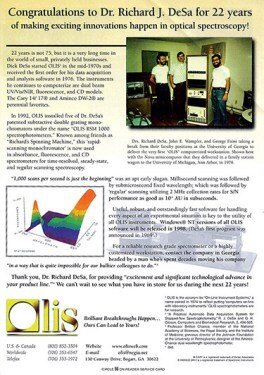What Does Spectrophotometers Mean?
What Does Spectrophotometers Mean?
Blog Article
The Facts About Uv/vis Uncovered
Table of ContentsSee This Report on Uv/visWhat Does Uv/vis/nir Do?Rumored Buzz on Uv/visSome Known Questions About Uv/vis/nir.The 10-Second Trick For Circularly Polarized Luminescence

Although spectrophotometry is most typically applied to ultraviolet, noticeable, and infrared radiation, contemporary spectrophotometers can question wide swaths of the electromagnetic spectrum, including x-ray, ultraviolet, visible, infrared, and/or microwave wavelengths. Spectrophotometry is a tool that depends upon the quantitative analysis of molecules depending on just how much light is soaked up by colored substances.
The 5-Second Trick For Circular Dichroism
A spectrophotometer is typically used for the measurement of transmittance or reflectance of services, transparent or nontransparent solids, such as polished glass, or gases. Many biochemicals are colored, as in, they soak up visible light and for that reason can be measured by colorimetric procedures, even colorless biochemicals can typically be transformed to colored compounds suitable for chromogenic color-forming reactions to yield substances ideal for colorimetric analysis.: 65 However, they can likewise be created to determine the diffusivity on any of the listed light varieties that usually cover around 2002500 nm utilizing different controls and calibrations.
An example of an experiment in which spectrophotometry is used is the determination of the stability constant of a service. A specific chain reaction within a solution may occur in a forward and reverse instructions, where reactants form items and products break down into reactants. Eventually, this chain reaction will reach a point of balance called an equilibrium point.
The Best Strategy To Use For Circularly Polarized Luminescence
The amount of light that goes through the option is indicative of the concentration of particular chemicals that do not allow light to go through. The absorption of light is due to the interaction of light with the electronic and vibrational modes of molecules. Each kind of molecule has a specific set of energy levels related to the makeup of its chemical bonds and nuclei and therefore will take in light of specific wavelengths, or energies, leading to special spectral properties.
They are widely utilized in many industries including semiconductors, laser and optical manufacturing, printing and forensic examination, as well as in laboratories for the study of chemical substances. Spectrophotometry is typically utilized in measurements of enzyme activities, determinations of protein concentrations, decisions of enzymatic kinetic constants, and measurements of ligand binding reactions.: 65 Eventually, a spectrophotometer is able to next determine, depending on the control or calibration, what substances are present in a target and precisely how much through computations of observed wavelengths.
This would come as a service to the previously produced spectrophotometers which were unable to take in the ultraviolet correctly.
More About Circularly Polarized Luminescence
It would be found that this did not offer satisfying outcomes, therefore in Model B, there was a shift from a glass to a quartz prism which enabled better absorbance outcomes - spectrophotometers (http://www.video-bookmark.com/bookmark/6114703/olis-clarity/). From there, Design C was born with a change to the wavelength resolution which wound up having three units of it produced
It irradiates the sample with polychromatic light which the sample absorbs depending upon its residential or commercial properties. It is sent back by grating the photodiode range which spots the wavelength area of the spectrum. Ever since, the development and application of spectrophotometry gadgets has increased immensely and has actually become one of the most innovative instruments of our time.

The smart Trick of Circularly Polarized Luminescence That Nobody is Discussing
The grating can either be movable or fixed.
In such systems, the grating is fixed and the intensity of each wavelength of light is determined by a various detector in the selection. When making transmission measurements, the spectrophotometer quantitatively compares the portion of light that passes through a reference solution and a test solution, then digitally compares the strengths of the 2 signals and computes the portion of transmission of the sample compared to the recommendation requirement.

Report this page